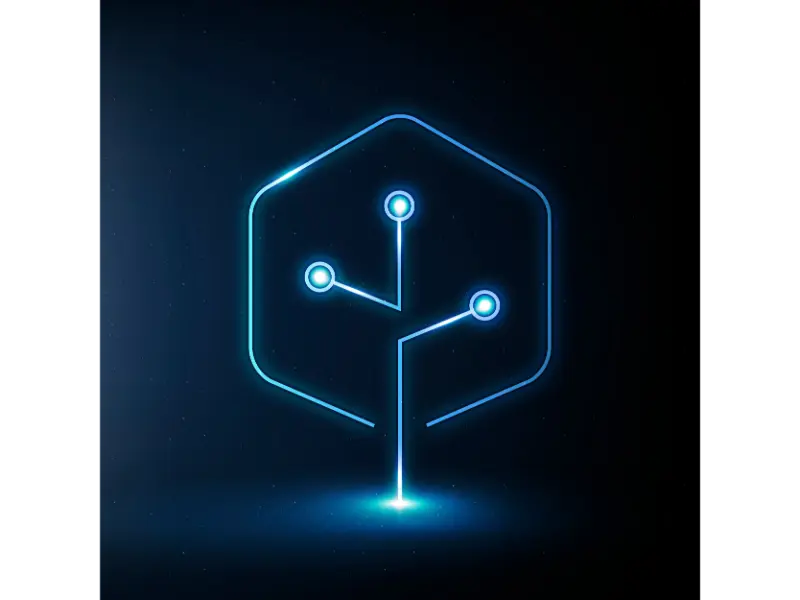- Blockchain technology is a decentralized, distributed ledger system that ensures secure, transparent, and immutable transactions across a network of computers.
- It has wide-ranging applications beyond cryptocurrencies, including supply chain management, healthcare, voting systems, and smart contracts.
Blockchain technology has emerged as one of the most revolutionary innovations of the 21st century. From cryptocurrency to supply chain management, its potential applications span across various industries. But what exactly is blockchain technology, and why is it creating such a buzz?
In simple terms, blockchain technology is a decentralized, distributed ledger system that allows data to be securely stored across multiple computers. Unlike traditional databases that rely on a central authority, blockchain operates on a peer-to-peer network, making it more transparent, secure, and less vulnerable to manipulation. This feature has made blockchain a foundational technology for cryptocurrencies like Bitcoin, but its potential goes far beyond just financial applications.
In this article, we will break down blockchain technology, explore how it works, and discuss its key features, advantages, and potential use cases across different industries.
Also read: Bitget joins TRON and SunPump to boost blockchain growth
Also read: Spacecoin launches satellite for blockchain in space
Understanding blockchain technology: The basics

Blockchain is often described as a “digital ledger” or “distributed ledger” because it records transactions in a manner that is both secure and transparent. Unlike centralized systems, where a single entity (like a bank or government) manages the database, blockchain operates on a decentralized network of computers, known as nodes.
Each node maintains a copy of the entire blockchain, making it virtually impossible for any single entity to alter or manipulate the data without the consensus of the network. According to Vitalik Buterin, the co-founder of Ethereum, “The beauty of blockchain lies in its decentralized nature, which removes the need for trust in any single entity.”
The term “blockchain” comes from the way data is structured. Data is grouped into “blocks” that are linked or “chained” together using cryptography. Every new block contains a cryptographic hash of the previous block, ensuring that once a block is added to the chain, it cannot be altered without changing all subsequent blocks, which would require the approval of the network.
As IBM’s blockchain expert, Marie Wieck, states, “Blockchain’s immutability ensures that data, once entered, cannot be tampered with, providing a level of security and transparency that traditional systems simply cannot offer.”
The beauty of blockchain lies in its decentralized nature, which removes the need for trust in any single entity.
Vitalik Buterin, the co-founder of Ethereum
Also read: Avara’s Lens raises $31M for SocialFi blockchain launch
Also read: Pyth Network brings real-time oil data to over 80 blockchains
Key features of blockchain technology

To better understand blockchain technology, it’s essential to dive into its key features:
- Immutability
Blockchain technology is immutable, meaning once a piece of data is added to the blockchain, it cannot be changed or deleted. This property ensures data integrity, making it an ideal solution for applications where trust and verification are critical, such as in financial transactions or medical records. - Transparency
All transactions recorded on the blockchain are visible to all participants in the network. This level of transparency helps reduce fraud, increases accountability, and fosters trust among users. However, depending on the type of blockchain, the degree of transparency can vary. Public blockchains, like Bitcoin, allow anyone to view transactions, while private blockchains may restrict access to certain parties. - Security
Blockchain uses cryptographic techniques to secure data. Each block contains a unique hash, which is generated using the data in the block and the hash of the previous block. This makes blockchain resistant to hacking or tampering, as altering any block would require recalculating all subsequent blocks, which is computationally infeasible.
Also read: Syscoin unveils roadmap to scale Bitcoin with modular blockchain
Also read: Sui blockchain partners with Ant Digital on tokenised ESG assets
How blockchain technology works

Blockchain operates through a process that involves several key steps. These steps ensure that data is added to the blockchain in a secure, transparent, and reliable way:
Transaction initiation
A user initiates a transaction by creating a digital record on the blockchain. For example, if you’re transferring cryptocurrency to another person, you create a transaction request that includes details such as the amount and recipient’s address. As blockchain expert Andreas M. Antonopoulos notes, “The power of blockchain is in its ability to allow trustless, peer-to-peer transactions without the need for intermediaries.”
Verification by network nodes
Once the transaction is initiated, it is sent to the network of nodes for verification. In most blockchain systems, this process is done through consensus mechanisms, which allow nodes to agree on the validity of the transaction. Popular consensus mechanisms include Proof of Work (PoW) and Proof of Stake (PoS). According to Bill Gates, “Blockchain’s decentralized verification process ensures that data is secure, and anyone can trust the system without needing to trust any single participant.”
Creating a new block
If the transaction is validated, it is grouped with other transactions to form a new block. This block is then added to the existing blockchain, with a cryptographic hash linking it to the previous block. As blockchain pioneer Don Tapscott points out, “Each block is a permanent record of the transaction, making it virtually impossible for any block to be altered or tampered with, ensuring data integrity across the entire system.
Finalization and transparency
Once the block is added, the transaction becomes part of the immutable blockchain. The updated blockchain is shared with all participants in the network, ensuring that everyone has the same, up-to-date copy of the ledger. This transparency, as Tapscott emphasizes, is a core advantage: “Blockchain allows every participant to have access to the same version of the truth, creating unprecedented trust and accountability.”
The power of blockchain is in its ability to allow trustless, peer-to-peer transactions without the need for intermediaries.
Andreas M. Antonopoulos, a blockchain expert
Also read: Nevada adopts blockchain to secure elections
Also read: FIFA Rivals: Football, blockchain, and what fans need to know
Types of blockchain

There are several different types of blockchain, each with its own set of features and use cases. These include:
- Public blockchain
Public blockchains are open to anyone and everyone. Anyone can participate in the network by verifying transactions, and they are typically decentralized. Bitcoin and Ethereum are examples of public blockchains. - Hybrid blockchain
Hybrid blockchains combine the features of both public and private blockchains. They allow certain parts of the blockchain to be private, while others remain public, providing flexibility and control to users.
Advantages of blockchain technology

The widespread adoption of blockchain technology has been driven by its unique advantages, which make it particularly useful for applications that require secure, transparent, and decentralized solutions.
Increased security
Blockchain’s use of cryptography ensures that data is secure from hacking or unauthorized access. The decentralized nature of the network also reduces the risk of a single point of failure, making blockchain more robust than traditional centralized systems.
Reduced costs
By eliminating intermediaries, such as banks, brokers, or payment processors, blockchain can help reduce transaction fees and streamline operations. This is especially evident in the financial sector, where blockchain allows for direct peer-to-peer transactions, cutting out the need for third-party verification.
Faster transactions
Traditional financial transactions can take days to process, especially for cross-border payments. Blockchain technology can facilitate faster transactions by bypassing intermediaries and reducing the need for manual processing.
Transparency and trust
Blockchain’s transparent ledger allows all participants to verify transactions in real time, reducing the potential for fraud and increasing trust among users. This is especially beneficial in industries such as finance, healthcare, and supply chain management.
Applications of blockchain technology

Blockchain technology has already found applications in a wide range of industries. Some of the most notable use cases include:
Blockchain and cryptocurrencies
Cryptocurrencies like Bitcoin, Ethereum, and others are perhaps the most well-known use cases of blockchain technology. These digital currencies rely on blockchain’s decentralized ledger to record and verify transactions, allowing users to send and receive money without the need for a centralized authority, such as a bank. As Bitcoin creator Satoshi Nakamoto famously said, “We have proposed a system for electronic transactions without relying on trust.” This is the core principle behind cryptocurrencies: trust in the technology itself, not in any central authority.
According to crypto expert Andreas M. Antonopoulos, “Blockchain removes the need for a middleman by creating an open, decentralized system that allows individuals to transact freely with one another.”
Blockchain in supply chain management
Blockchain can be used to track and verify the movement of goods throughout a supply chain. This provides transparency and traceability, ensuring that products are sourced ethically and meet quality standards. Companies like IBM and Maersk have already started using blockchain to streamline supply chain operations. As IBM’s General Manager for Blockchain, Marie Wieck, explains, “Blockchain provides the transparency and accountability needed to create trust and ensure the integrity of the supply chain.”
By implementing blockchain, businesses can not only increase operational efficiency but also verify the authenticity of goods, a critical factor in industries like pharmaceuticals and luxury goods. As supply chain expert and author, Dr. Michael J. Casey, states, “Blockchain ensures the provenance of products, enabling consumers to verify the origin and ethical standards of goods.”

Blockchain in healthcare
In the healthcare industry, blockchain can be used to securely store and share patient medical records. Blockchain’s immutability ensures that medical data cannot be tampered with, while its decentralized nature allows multiple healthcare providers to access and update patient records, improving efficiency and patient care. According to Dr. Karen S. Smith, a healthcare innovation expert, “Blockchain provides an unprecedented level of security and privacy for sensitive medical data, while also allowing for greater interoperability between different healthcare systems.” This ability to maintain secure, immutable records is crucial for improving patient care, reducing errors, and preventing fraud.
Blockchain in voting systems
Blockchain has the potential to revolutionize voting systems by providing a secure and transparent way to record votes. By using blockchain, elections can be made more secure and tamper-proof, reducing the risk of fraud and ensuring that results are accurate and verifiable.
As blockchain advocate Don Tapscott notes, “Blockchain’s transparency and immutability can ensure that every vote is securely recorded, with no opportunity for tampering or manipulation.” This feature is especially important in the context of elections, where trust and security are paramount. “The application of blockchain could allow for elections that are more accessible, efficient, and trustworthy,” says Tapscott.
Blockchain for smart contracts
Smart contracts are self-executing contracts with the terms of the agreement directly written into code. Blockchain technology can be used to deploy and execute these contracts, automatically carrying out actions when predefined conditions are met. This has applications in industries ranging from real estate to legal services. According to Ethereum co-founder Vitalik Buterin, “Smart contracts enable automated execution of contracts, reducing human error and ensuring that agreements are enforced without intermediaries.”
As legal expert Marc Andreessen explains, “Smart contracts eliminate the need for traditional legal structures and empower individuals to execute agreements directly, cutting out time and cost.” The flexibility and security of smart contracts make them highly appealing for automating business processes and ensuring compliance in sectors like insurance and finance.
Blockchain provides the transparency and accountability needed to create trust and ensure the integrity of the supply chain.
Marie Wieck, the IBM’s General Manager for Blockchain
Challenges of blockchain technology

Despite its many advantages, blockchain technology still faces several challenges:
- Scalability
As the number of transactions on a blockchain network grows, the system can become slow and inefficient. While there are ongoing efforts to improve scalability, such as the development of Ethereum 2.0, scalability remains a challenge for many blockchain platforms. - Energy consumption
Some consensus mechanisms, such as Proof of Work, require significant computational power, leading to high energy consumption. This has raised concerns about the environmental impact of blockchain technology, especially in cryptocurrency mining. - Regulation
The decentralized and anonymous nature of blockchain can make it difficult for governments to regulate. As blockchain adoption grows, it is likely that regulators will need to develop new frameworks to address issues such as fraud, money laundering, and taxation. - Adoption and integration
While blockchain has many potential benefits, it can be difficult to integrate into existing systems. Organizations may face resistance to adopting new technologies, and transitioning to a blockchain-based system requires significant investment in infrastructure and training.
FAQ
Blockchain is a decentralized and distributed digital ledger that records transactions across a network of computers. It ensures security, transparency, and immutability, making it ideal for applications like cryptocurrencies, supply chain management, and more.
Blockchain uses cryptographic techniques and consensus mechanisms (like Proof of Work or Proof of Stake) to verify and secure transactions. Once data is added to a blockchain, it cannot be altered without the agreement of the network, ensuring high levels of security and trust.
Blockchain has applications in various industries, including cryptocurrency (e.g., Bitcoin), supply chain management, healthcare (secure medical records), voting systems, and executing smart contracts in finance and real estate.
No, blockchain is the underlying technology that powers Bitcoin and other cryptocurrencies. While Bitcoin is a digital currency, blockchain is the framework that ensures secure and transparent transactions in numerous use cases beyond cryptocurrencies.
Despite its advantages, blockchain faces challenges like high energy consumption (in some consensus models), scalability issues, regulatory uncertainty, and the need for technical expertise to implement and manage systems effectively.

